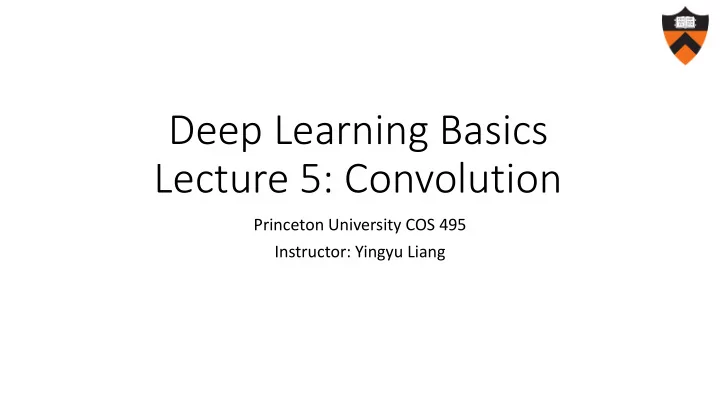

Deep Learning Basics Lecture 5: Convolution Princeton University COS 495 Instructor: Yingyu Liang
Convolutional neural networks • Strong empirical application performance • Convolutional networks: neural networks that use convolution in place of general matrix multiplication in at least one of their layers ℎ = 𝜏(𝑋 𝑈 𝑦 + 𝑐) for a specific kind of weight matrix 𝑋
Convolution
Convolution: math formula • Given functions 𝑣(𝑢) and 𝑥(𝑢) , their convolution is a function 𝑡 𝑢 𝑡 𝑢 = ∫ 𝑣 𝑏 𝑥 𝑢 − 𝑏 𝑒𝑏 • Written as 𝑡 = 𝑣 ∗ 𝑥 or 𝑡 𝑢 = (𝑣 ∗ 𝑥)(𝑢)
Convolution: discrete version • Given array 𝑣 𝑢 and 𝑥 𝑢 , their convolution is a function 𝑡 𝑢 +∞ 𝑡 𝑢 = 𝑣 𝑏 𝑥 𝑢−𝑏 𝑏=−∞ • Written as 𝑡 = 𝑣 ∗ 𝑥 or 𝑡 𝑢 = 𝑣 ∗ 𝑥 𝑢 • When 𝑣 𝑢 or 𝑥 𝑢 is not defined, assumed to be 0
Illustration 1 𝑥 = [z, y, x] 𝑣 = [a, b, c, d, e, f] xb+yc+zd x y z a b c d e f
Illustration 1 xc+yd+ze x y z a b c d e f
Illustration 1 xd+ye+zf x y z a b c d e f
Illustration 1: boundary case xe+yf x y a b c d e f
Illustration 1 as matrix multiplication y z a x y z b x y z c x y z d x y z e x y f
Illustration 2: two dimensional case a b c d w x e f g h y z i j k l wa + bx + ey + fz
Illustration 2 a b c d w x e f g h y z i j k l wa + bx + bw + cx + ey + fz fy + gz
Illustration 2 Input Kernel (or filter) a b c d w x e f g h y z i j k l wa + bx + bw + cx + ey + fz fy + gz Feature map
Advantage: sparse interaction Fully connected layer, 𝑛 × 𝑜 edges 𝑛 output nodes 𝑜 input nodes Figure from Deep Learning, by Goodfellow, Bengio, and Courville
Advantage: sparse interaction Convolutional layer, ≤ 𝑛 × 𝑙 edges 𝑛 output nodes 𝑙 kernel size 𝑜 input nodes Figure from Deep Learning, by Goodfellow, Bengio, and Courville
Advantage: sparse interaction Multiple convolutional layers: larger receptive field Figure from Deep Learning, by Goodfellow, Bengio, and Courville
Advantage: parameter sharing The same kernel are used repeatedly. E.g., the black edge is the same weight in the kernel. Figure from Deep Learning, by Goodfellow, Bengio, and Courville
Advantage: equivariant representations • Equivariant: transforming the input = transforming the output • Example: input is an image, transformation is shifting • Convolution(shift(input)) = shift(Convolution(input)) • Useful when care only about the existence of a pattern, rather than the location
Pooling
Terminology Figure from Deep Learning, by Goodfellow, Bengio, and Courville
Pooling • Summarizing the input (i.e., output the max of the input) Figure from Deep Learning, by Goodfellow, Bengio, and Courville
Advantage Induce invariance Figure from Deep Learning, by Goodfellow, Bengio, and Courville
Motivation from neuroscience • David Hubel and Torsten Wiesel studied early visual system in human brain (V1 or primary visual cortex), and won Nobel prize for this • V1 properties • 2D spatial arrangement • Simple cells: inspire convolution layers • Complex cells: inspire pooling layers
Variants of convolution and pooling
Variants of convolutional layers • Multiple dimensional convolution • Input and kernel can be 3D • E.g., images have (width, height, RBG channels) • Multiple kernels lead to multiple feature maps (also called channels) • Mini-batch of images have 4D: (image_id, width, height, RBG channels)
Variants of convolutional layers • Padding: valid xd+ye+zf x y z a b c d e f
Variants of convolutional layers • Padding: same xe+yf x y a b c d e f
Variants of convolutional layers • Stride Figure from Deep Learning, by Goodfellow, Bengio, and Courville
Variants of convolutional layers • Others: • Tiled convolution • Channel specific convolution • ……
Variants of pooling • Stride and padding Figure from Deep Learning, by Goodfellow, Bengio, and Courville
Variants of pooling • Max pooling 𝑧 = max{𝑦 1 , 𝑦 2 , … , 𝑦 𝑙 } • Average pooling 𝑧 = mean{𝑦 1 , 𝑦 2 , … , 𝑦 𝑙 } • Others like max-out
Recommend
More recommend